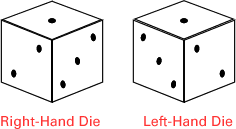| The opposite
faces of an ordinary six-sided die always
add up to 7.
There are "right-handed"
and "left-handed" dice. In Europe
and the Americas, dice are typically right-handed. This
means that if the 1 is face up, and the 2 is facing you,
then the 3 will be on your right:

In Asia, dice typically have the 3 on the
left. |

|
A
branch of mathematics known as
probability
got its start in 1654, when Blaise
Pascal and his friend,
the Chevalier de Méré, tried
to analyze a game of dice.
Dice were developed
from ancient games played with sheep
knucklebones, called astragali
in Greek, and tali
in Latin. The bones from sheep's ankles were used to tell
fortunes. Called "rolling
bones," they were basically rectangular
and had numbers on only four sides.
A die with four faces
is a tetrahedron.
A die with twelve faces is a dodecahedron.
A die with twenty faces is an icosahedron. |
